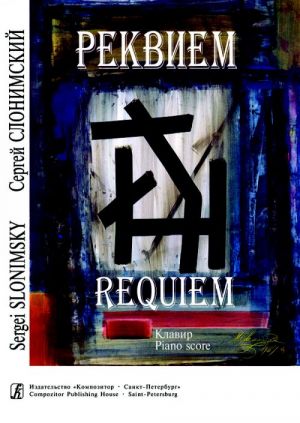Sergei Mikhailovich Slonimsky (born in 1932) is one of the leading composers belonging to the modern Russian music, the author of works in different genres, from operas and symphonies to cinema sound-tracks.
The Requiem dates 2003. This grand canvas is distinct from the numerous similar compositions of this genre. It happens because of the text order, which is changed in comparison with the canonic ecclesiastic one. The music history witnessed the cases of this genre's (established in the 14th century) free interpretation. Remember the requiems by Ockeghem, Orlando Lasso and their contemporaries. Not all the Roman canon's movements are present in those works. Gabriel Faure omitted “Dies irae” in the 19th century, while Benjamin Britten amalgamated canonic Latin texts with the English verses in his “War Requiem” dating the 20th century. The Requiem's German tradition allows to resort to the Lutheran Bible's verses instead of the Latin ones. v=Q6YiGcMIhWk
It took rather a long time to make the Requiem independent of the church service. Now it's affirmed as the mere musical genre.
Slonimsky's Requiem is not initially implied as the part of some ritual. Lofty thoughts, repentance, the prayer of sins' redemption. The composer sets himself free of the canonic textual disposition, marking the most vital shades of meaning, which emotional kernel looks extremely burning for his mind.
Contents:
I. LACRIMOSA
II. DIES IRAE
III. REQUIEM AETERNAM
IV. LUX AETERNA
V. TUBA MIRUM
VI. AGNUS DEI
VII. REX TREMENDAE MAJESTATIS
VIII. DOMINE JESU
IX. HOSTIAS
X. SANCTUS
XI. BENEDICTUS
XII. LIBERA ME
XIII. KYRIE ELEISON
XIV. LACRIMOSA
v=Q6YiGcMIhWk
Sergei Mikhailovich Slonimsky (born in 1932) is one of the leading composers belonging to the modern Russian music, the author of works in different genres, from operas and symphonies to cinema sound-tracks.
The Requiem dates 2003. This grand canvas is distinct from the numerous similar compositions of this genre. It happens because of the text order, which is changed in comparison with the canonic ecclesiastic one. The music history witnessed the cases of this genre's (established in the 14th century) free interpretation. Remember the requiems by Ockeghem, Orlando Lasso and their contemporaries. Not all the Roman canon's movements are present in those works. Gabriel Faure omitted “Dies irae” in the 19th century, while Benjamin Britten amalgamated canonic Latin texts with the English verses in his “War Requiem” dating the 20th century. The Requiem's German tradition allows to resort to the Lutheran Bible's verses instead of the Latin ones.
It took rather a long time to make the Requiem independent of the church service. Now it's affirmed as the mere musical genre.
Slonimsky's Requiem is not initially implied as the part of some ritual. Lofty thoughts, repentance, the prayer of sins' redemption. The composer sets himself free of the canonic textual disposition, marking the most vital shades of meaning, which emotional kernel looks extremely burning for his mind.
Contents:
I. LACRIMOSA
II. DIES IRAE
III. REQUIEM AETERNAM
IV. LUX AETERNA
V. TUBA MIRUM
VI. AGNUS DEI
VII. REX TREMENDAE MAJESTATIS
VIII. DOMINE JESU
IX. HOSTIAS
X. SANCTUS
XI. BENEDICTUS
XII. LIBERA ME
XIII. KYRIE ELEISON
XIV. LACRIMOSA
v=Q6YiGcMIhWk
Сергей Михайлович Слонимский (р. 1932 г.) — один из интереснейших отечественных композиторов настоящего времени, автор произведений во всех жанрах: от опер и симфоний до мелодий для кинематографа.
Реквием создан композиторов в 2003 году. От большинства произведений в этом жанре он отличается измененным — по сравнению с каноническим — порядком следования текстов. Реквием Слонимского изначально не предназначается для совершения обряда. Этот жанр для композитора служит носителем общей идеи покаяния, мольбы об отпущении грехов. Произвольно чередуя тексты, автор акцентирует те смысловые и эмоциональные моменты, которые важны для него в выражении этой идеи.
Содержание:
I. LACRIMOSA
II. DIES IRAE
III. REQUIEM AETERNAM
IV. LUX AETERNA
V. TUBA MIRUM
VI. AGNUS DEI
VII. REX TREMENDAE MAJESTATIS
VIII. DOMINE JESU
IX. HOSTIAS
X. SANCTUS
XI. BENEDICTUS
XII. LIBERA ME
XIII. KYRIE ELEISON
XIV. LACRIMOSA
v=Q6YiGcMIhWk
Sergej Mikhajlovich Slonimskij (r. 1932 g.) — odin iz interesnejshikh otechestvennykh kompozitorov nastojaschego vremeni, avtor proizvedenij vo vsekh zhanrakh: ot oper i simfonij do melodij dlja kinematografa.
Rekviem sozdan kompozitorov v 2003 godu. Ot bolshinstva proizvedenij v etom zhanre on otlichaetsja izmenennym — po sravneniju s kanonicheskim — porjadkom sledovanija tekstov. Rekviem Slonimskogo iznachalno ne prednaznachaetsja dlja sovershenija obrjada. Etot zhanr dlja kompozitora sluzhit nositelem obschej idei pokajanija, molby ob otpuschenii grekhov. Proizvolno chereduja teksty, avtor aktsentiruet te smyslovye i emotsionalnye momenty, kotorye vazhny dlja nego v vyrazhenii etoj idei.
Soderzhanie:
I. LACRIMOSA
II. DIES IRAE
III. REQUIEM AETERNAM
IV. LUX AETERNA
V. TUBA MIRUM
VI. AGNUS DEI
VII. REX TREMENDAE MAJESTATIS
VIII. DOMINE JESU
IX. HOSTIAS
X. SANCTUS
XI. BENEDICTUS
XII. LIBERA ME
XIII. KYRIE ELEISON
XIV. LACRIMOSA













